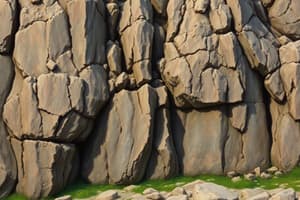Podcast
Questions and Answers
What is the primary effect of water freezing within rock cracks?
What is the primary effect of water freezing within rock cracks?
- It causes the water to evaporate instantly.
- It leads to an expansion in volume by up to 9%, exerting pressure. (correct)
- It reduces the volume of the crack substantially.
- It converts the frozen water into mineral crystals.
Which chemical weathering agent is described as forming new materials from ions released from rocks?
Which chemical weathering agent is described as forming new materials from ions released from rocks?
- Oxidation
- Solution (correct)
- Acid deposition
- Hydrolysis
How do lichens contribute to chemical weathering?
How do lichens contribute to chemical weathering?
- They create a weak acid that can dissolve rock. (correct)
- They produce strong acids that dissolve metals.
- They increase the erosion rate of sedimentary structures.
- They absorb minerals directly from rocks.
What role does carbonation play in chemical weathering?
What role does carbonation play in chemical weathering?
Which mineral is most susceptible to dissolution in acidic water?
Which mineral is most susceptible to dissolution in acidic water?
What is the main product of hydrolysis in chemical weathering?
What is the main product of hydrolysis in chemical weathering?
What is the result of oxidation as a chemical weathering process?
What is the result of oxidation as a chemical weathering process?
What role do plant roots play in the process of chemical weathering?
What role do plant roots play in the process of chemical weathering?
What causes the vertical movement of the crustal blocks in a reverse fault?
What causes the vertical movement of the crustal blocks in a reverse fault?
Which fault is associated with the formation of a valley due to blocks pulling apart?
Which fault is associated with the formation of a valley due to blocks pulling apart?
Which of the following is an example of a strike-slip fault?
Which of the following is an example of a strike-slip fault?
In what type of tectonic boundary does a reverse fault predominantly occur?
In what type of tectonic boundary does a reverse fault predominantly occur?
What geological phenomenon is suggested by the concept of seafloor spreading?
What geological phenomenon is suggested by the concept of seafloor spreading?
What is mass wasting primarily influenced by?
What is mass wasting primarily influenced by?
Which of the following is NOT an example of mass wasting?
Which of the following is NOT an example of mass wasting?
What is the main driving force behind the rock cycle?
What is the main driving force behind the rock cycle?
What role does the water cycle play in the rock cycle?
What role does the water cycle play in the rock cycle?
What happens to the mass wasting process if the Earth's core becomes cooler?
What happens to the mass wasting process if the Earth's core becomes cooler?
Which factor is crucial for the continuation of the rock cycle?
Which factor is crucial for the continuation of the rock cycle?
What is meant by primordial heat in the context of the Earth?
What is meant by primordial heat in the context of the Earth?
What would happen if there were no atmosphere around the Earth?
What would happen if there were no atmosphere around the Earth?
What is characteristic of burial metamorphism?
What is characteristic of burial metamorphism?
Which type of metamorphism is commonly associated with mountain building?
Which type of metamorphism is commonly associated with mountain building?
In subduction zones, what conditions are notable during metamorphism?
In subduction zones, what conditions are notable during metamorphism?
What is the primary factor that drives contact metamorphism?
What is the primary factor that drives contact metamorphism?
Which of the following rocks is typically associated with contact metamorphism?
Which of the following rocks is typically associated with contact metamorphism?
What distinguishes regional metamorphism from other types of metamorphism?
What distinguishes regional metamorphism from other types of metamorphism?
Which metamorphic process results in foliated rocks due to directional pressure?
Which metamorphic process results in foliated rocks due to directional pressure?
Why is contact metamorphism referred to as high temperature, low pressure metamorphism?
Why is contact metamorphism referred to as high temperature, low pressure metamorphism?
What type of deformation occurs when a rock permanently changes in shape after being bent or folded?
What type of deformation occurs when a rock permanently changes in shape after being bent or folded?
Which factor reduces the likelihood of rocks fracturing under high confining pressures?
Which factor reduces the likelihood of rocks fracturing under high confining pressures?
What forms as a result of compressional forces at convergent plate boundaries?
What forms as a result of compressional forces at convergent plate boundaries?
Which of the following describes the movement along a fault line?
Which of the following describes the movement along a fault line?
What is the primary characteristic of elastic deformation?
What is the primary characteristic of elastic deformation?
Which type of fault occurs when rocks slide past each other horizontally?
Which type of fault occurs when rocks slide past each other horizontally?
What type of deformation is referred to when a rock undergoes breaking or fracturing?
What type of deformation is referred to when a rock undergoes breaking or fracturing?
How does temperature affect rock behavior under stress?
How does temperature affect rock behavior under stress?
Flashcards are hidden until you start studying
Study Notes
Weathering
- Water freezing and expanding can cause rock to break off
- Salt crystal growth can also cause rock to break off
- Chemical weathering is the process of ions being released into water or recombining to form new materials like clay
- Oxidation is a type of chemical weathering, where oxygen reacts with minerals in rocks
- Solution is a type of chemical weathering where rock dissolves in water
- Carbonation is a type of solution weathering where carbon dioxide and water react with carbonate rocks like limestone
- Hydrolysis is a type of chemical weathering where water reacts with minerals in rocks
- Acids and chemicals from organisms can also cause chemical weathering, for example, lichens can produce weak acids that dissolve rock
Mass Wasting
- It is the downslope movement of surface materials due to gravity
- Examples of mass wasting include landslides, mudflows, debris flows, avalanches, and slumps
Earth's Structure
- The Earth's crust is constantly changing through the rock cycle
- Two forces drive the rock cycle: internal heat engine and the water cycle
- The Earth's core is hot enough to drive mantle convection
Rock Cycle
- Burial metamorphism happens when sediments are buried deeply enough that heat and pressure cause minerals to recrystallize
- Regional metamorphism occurs when large areas of rocks are subjected to differential stress over long periods of time, often associated with mountain building
- Subduction metamorphism occurs at subduction zones where tectonic plates collide, resulting in high pressures and relatively low temperatures
Metamorphism
- Contact metamorphism happens when a body of magma intrudes into an adjacent body of rock, causing the rock to heat up and become infiltrated with fluids from the magma
- Contact metamorphism often happens in small areas called metamorphic aureoles
- Contact metamorphism is considered high-temperature, low-pressure metamorphism
- Rocks deform through fracturing and faulting at low confining pressures near the Earth's surface
- Rocks deform by folding at high confining pressures deep within the Earth's crust
Rock Deformation
- Elastic deformation occurs when a rock stretches but returns to its original shape
- Ductile deformation occurs when a rock permanently changes shape after being bent or folded
- Irreversible deformation occurs when a rock permanently changes shape and size due to breaking or fracturing
- Factors that affect rock deformation: confining pressure, temperature, strength of rock, strain rate
Folding
- Folding is the bending of rocks when forces are applied on it at opposite directions
- Common along convergent plate boundaries and usually results in mountain building
- Anticline is the upfold, and syncline is the downfold
Faulting
- Faulting is the process of causing a fracture or break in a rock due to shear stress
- This can result in earthquakes
- A fracture is a simple break that does not involve significant movement of the rocks on either side
- A fault is a boundary between two bodies of rock along which there has been relative motion
- Normal fault is a dip-slip fault in which the block above the fault has moved downward relative to the block below
- Reverse fault is a dip-slip fault in which the upper block, above the fault plane, moves up and over the lower block
- A strike-slip fault is due to the shearing or the sliding of rocks
Seafloor Spreading
- The idea of continental drift implies that something must have separated the continents
- The theory of seafloor spreading explains how continents can move apart
Studying That Suits You
Use AI to generate personalized quizzes and flashcards to suit your learning preferences.




